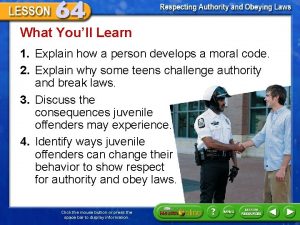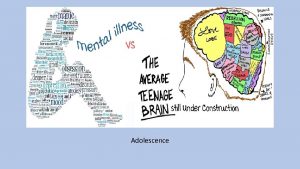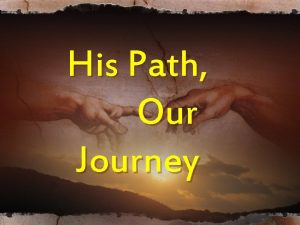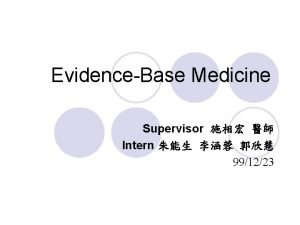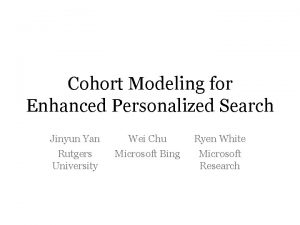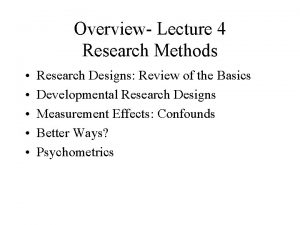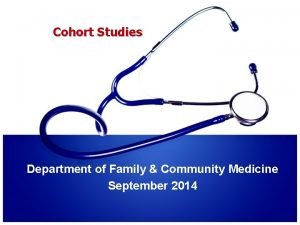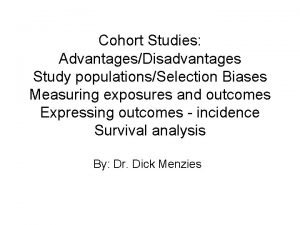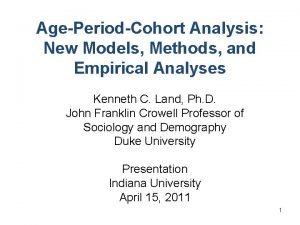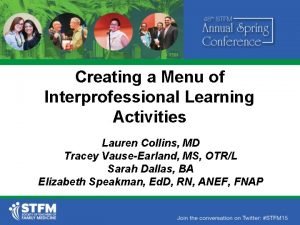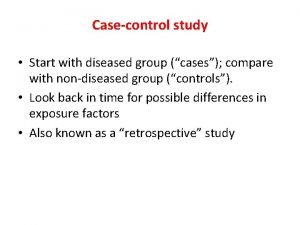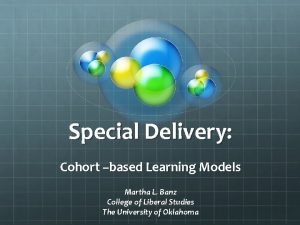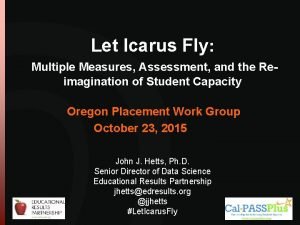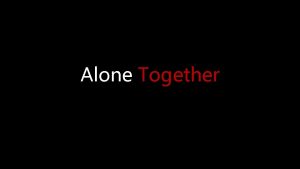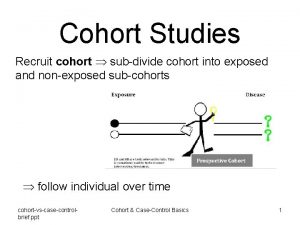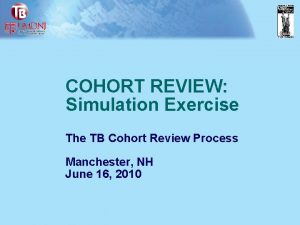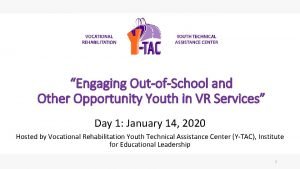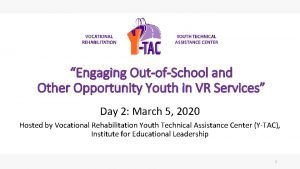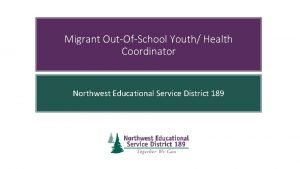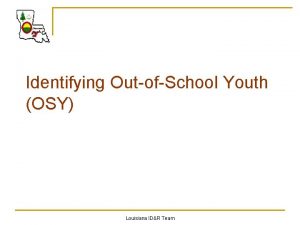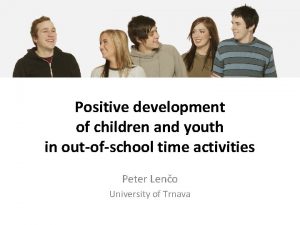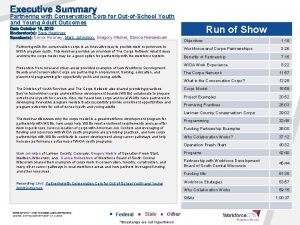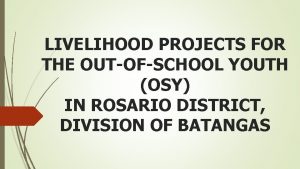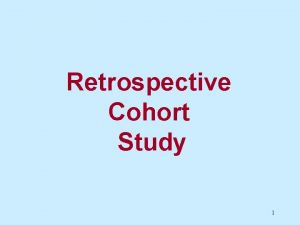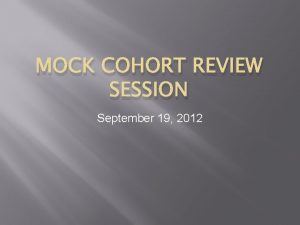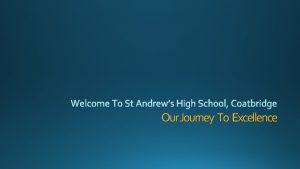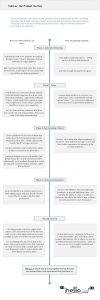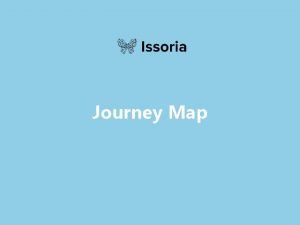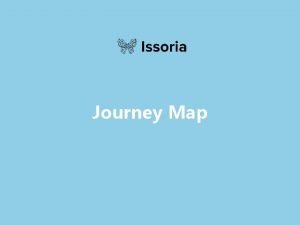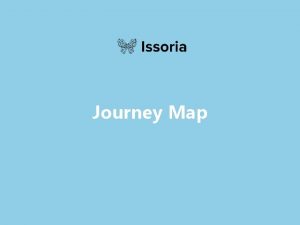Our Journey Together OutofSchool Youth Cohort Challenge Review























































- Slides: 55

Our Journey Together: Out-of-School Youth Cohort Challenge Review Thursday, June 7 th, 2018 2: 30 -3: 30 PM ET Out of School Youth

Your Presenters Moderator, Lisa Dieterle, Federal Project Officer, Region V WIOA Youth Program Lead, US DOLETA Amy Landesman, Consultant, Maher & Maher Matt Musante, Analyst, Maher & Maher Out of School Youth

Welcome Moderator, Lisa Dieterle, Federal Project Officer, Region V WIOA Youth Program Lead, US DOLETA Out of School Youth

Session Objectives • Cohort Overview (purpose and structure) • Youth Engagement and Retention Challenges • Key Insights and Opportunities Identified • Outcomes Out of School Youth

What are we experiencing? An opportunity to hear from you……… Out of School Youth

OSY Cohort Overview What was the purpose and structure? Out of School Youth

Cohort Initiative - Purpose • Cohorts across five different focus areas tackled various challenges in the workforce development system – – – The Future of American Job Centers (AJCs) Integrating Business Services Across a Region State WIOA, TANF and SNAP Partnerships Operationalizing WIOA Co-enrollment Engaging and Retaining Out-of-School Youth Out of School Youth

Cohorts - The Approach Bring together multiple voices, perspectives, experiences, and expertise to the table. Identify and further understand challenge, develop innovative ideas and solutions that can benefit the entire system and each local cohort team. Out of School Youth

Our Focus “What does it take to effectively engage and retain out-of-school youth throughout the program lifespan? ” • Our goal was to develop outcomes that would: – Help cohort teams address the challenges in their own local areas – Develop practical solutions to the challenges to be disseminated to the field nationally – Serve as an overall “Innovation Lab” for ideas that could drive integration and promote increased efficiencies and improved outcomes Out of School Youth

Our Focus For the youth cohort, the teams would define what the specific challenges are in engaging and retaining out-of-school youth, and produce the deliverables/outcomes • Based on the belief the teams would know best the challenges and the solutions! Out of School Youth

What Happened? • 85 team applications representing states and local areas • Many partners were represented including workforce, public sector, community-based organizations, criminal justice, education, economic development, community colleges, literacy, employers, etc. • 8 teams were chosen (5 -7 members each) Out of School Youth

The Teams Career Center of Lowell (MA) Westmoreland. Fayette Workforce Investment Board (PA) S. Central TN Workforce Alliance (TN) Central Oklahoma (OK) South Dakota (SD) City of Brooklyn Park (MN) Ashtabula County/Youth Opportunities Program (OH) Orange County Development Board (CA) Out of School Youth

Cohort Components • 6 virtual sessions from February to May 2018 • Moodle - collaborative platform/shared space • Presentations introducing cohort team community models – Efforts to engage and retain youth – Successes/challenges – Goals moving forward • Independent and Team Assignments aimed to further understand identify challenges, learn best practices • Challenge Teams – worked on specific challenge areas identified by larger cohorts, developed deliverables Out of School Youth

Common Challenges Key patterns and themes Out of School Youth

Common Engagement Challenges • Outreach/recruitment/marketing • Immediate needs (job, income) vs. long-term goals (beyond entry-level jobs/career pathways) • Lack of commitment, motivation, “sticking it out” • Overcoming stigma for out of school youth Out of School Youth

Common Engagement Challenges • Need for support services – substance abuse, child care, mental health, legal services, etc. • Transportation • Housing and food security • Funding Out of School Youth

Challenge Teams • After examining best practices in engagement and retention strategies (pre-program, program and postprogram), topic areas were identified and four challenge teams were formed • Each Challenge Team, roughly 10 -12 people each, consisted of members from all 8 Cohort Teams • Each challenge team met independently to further their challenge area and develop their outcomes/deliverable Out of School Youth

Challenge Teams Empowering Youth as Active Participants #1 Using Technology in Innovative Ways Through Programming Recruitment, Marketing and Outreach Strategies Empowering Youth as Active Participants #2 Out of School Youth

Key Learnings of the Cohort What were the takeaways? Out of School Youth

Key Learnings • Many specific challenges affected all cohort teams • While rural areas face certain challenges, members realized many of the challenges derived from similar needs, pain points Out of School Youth

Key Learnings • Having cohort teams from different local entities on the team was an opportunity to develop new programming and practices – Several teams met in-person and used the time before and after the webinar to meet – Teams thought about how they could improve communication in the future – Teams thought about how they could leverage additional local partnerships or create new ones Out of School Youth

Key Learnings • Certain program topics surfaced as warranting further exploration locally – Assessment as a critical point of engagement – Using technology or using it more in programming – Peer centered approaches to programming • Hearing other teams’ best practices of what went well was helpful, but so were the lessons learned from what didn’t work out as well Out of School Youth

Key Learnings • Lower unemployment in many areas has allowed youth to obtain jobs faster but youth as a demographic still struggle when employers want highly skilled or semi-skilled workers – Engaging youth in credentialing and career pathway opportunities has become more challenging Out of School Youth

Lessons from the Cohort Team Norman Albances Program Administrator Orange County Development Board, OC Community Services - Community Investment Division Out of School Youth

About the OC • Population of 3. 1 million and the 6 th largest county in the United States • The Orange County Development Board (OCDB) administers a local workforce system for 2. 4 million of the region’s residents, serving 32 of the county’s 34 cities and all of the unincorporated communities of the county • In partnership with the Orange County Board of Supervisors, the OCDB oversees Orange County's workforce development activities and establishes programs in response to the workforce needs of Orange County, including labor market information, employment and training services, and business assistance. • Three service providers are split throughout the County to provide WIOA Youth services: the City of La Habra, KRA Corporation and the Orange County Asian and Pacific Islander Community Alliance (OCAPICA) • Team members have more than 30 years of WIA/WIOA experience combined

Name Title Organization Norman Albances Program Administrator Norman. albances@occr. ocgov. com John Gutierrez Program Manager Orange County Development Board Orange County Asian and Pacific Islander Community Alliance Justin Nguyen. Amigo Workforce Specialist Orange County Asian and Pacific Islander Community Alliance jamigo@ocapica. org Jacqueline Cortes Workforce Specialist Orange County Asian and Pacific Islander Community Alliance jcortes@ocapica. org Al Rodriguez Shawna Wright Program Manager Director of Workforce Operations Founder City of La Habra KRA Corporation AGRodriguez@lahabraca. gov swright@kra. com Orange County Opportunity Youth Collaborative ocyouthcollaborative@gmail. com Esther Landin Norman Justin John E-mail jgutierrez@ocapica. org Esther Al Jacqueline Shawna

What are you experiencing in your community working with youth? “They are need of supportive services especially in shelter and transportation. ” “They are experiencing homelessness, and therefore have a high level of need. ” “Young adults are more disengaged than they used to be. ” “Young adults are not connecting with society. ” “Young adults strong desire to become independent. ” Out of School Youth

What are your goals? • Continue to strengthen ways to keep youth motivated. • Ensuring that participants are empowered to have the ability to take initiative towards making healthy progressive steps forward in their professional & personal lives. • Listen more to participants to hear what they are up against and to see if they have their own answers to how to meet their goals. • Accompany participants in realizing their own potential, and to facilitate growth. • Developing a stackable credential option for young adults. • Increase enrollments. • Add whole person components to offerings (i. e. resiliency, understanding trauma). • Create partnerships with business and educational community for tours, training-to-employment pipelines, apprenticeships, professional community workshops, etc.

What are your goals? Human-Centered Design • Continue to strengthen ways to keep youth motivated. • Ensuring that participants are empowered to have the ability to take initiative towards making healthy progressive steps forward in their professional & personal lives. • Listen more to participants to hear what they are up against and to see if they have their own answers to how to meet their goals. • Accompany participants in realizing their own potential, and to facilitate growth. Partnership and Outreach • Increase enrollments. • Add whole person components to offerings (i. e. resiliency, understanding trauma). • Create partnerships with business and educational community for tours, training-to-employment pipelines, apprenticeships, professional community workshops, etc. • Developing a stackable credential option for young adults. Out of School Youth


Goal: Human-Centered Design • Text line • Online interest form for young adults and to refer young adults • Online workshops Out of School Youth

Goal: Human-Centered Design Motivational Interviewing: A collaborative, person-centered form of guiding to elicit and strengthen motivation for change. Motivational Interviewing is a goal-oriented, client-centered counseling style for eliciting behavior change by helping clients to explore and resolve doubt. Compared with nondirective counseling, it's more focused and goal -directed. The main goals of motivational interviewing are to engage clients, elicit change talk, and evoke client motivation to make positive changes. For example, change talk can be elicited by asking the client questions, such as "How might you like things to be different? "

Goal: Human-Centered Design • The Baldrige Excellence Framework has three parts: (1) the criteria for performance excellence (2) core values and concepts (3) scoring guidelines. The framework serves two main purposes: (1) to help organizations assess their improvement efforts, diagnose their overall performance management system, and identify their strengths and opportunities for improvement. (2) to identify Baldrige Award recipients that will serve as role models for other organizations. • California Workforce Association conferences

Goal: Human-Centered Design

Goal: Human-Centered Design • Developed electronic customer satisfaction surveys and added them to staff signatures: • Also have a survey for staff and partners.

Goal: Partnerships and Outreach To date: More than 90, 000 people reached!


Goal: Partnerships and Outreach

Goal: Partnerships and Outreach

Goal: Partnerships and Outreach • Strengthening Education and Workforce Development for Justice-Involved Young Adults – With support from the U. S. Department of Education’s Office of Career, Technical, and Adult Education, RTI International invited community partnerships to join a technical assistance initiative to improve the outcomes of justiceinvolved young adults (ages 16– 24). This new initiative will connect these youths with career and technical education (CTE), workforce development, and special education services. We were selected to participate in this initiative.

Goal: Partnerships and Outreach • Co-location and/or integrating into AJC Orientations

Outcomes of the Cohort What was developed…… Out of School Youth

Recruitment, Marketing and Outreach Strategies Tip Sheet • How to better reach youth • How to speak their language • Social media outlets youth are using • What to do if you are not social media savvy • Other relevant facts Out of School Youth

Empowering Youth as Active Participants Tip Sheet • Assessment survey questions and tools • Staff tips • Motivational interviewing techniques • Case scenarios Out of School Youth

Using Technology in Innovative Ways Through Programming Resource Guide • Relevant technology overview • How technology can be used in different phases of programming • Recommendations and precautions for how to effectively and appropriately use technology • Information about no/low cost technology tools Out of School Youth

Lessons from the Challenge Team Experience Yolanda Scott Program Manager-Youth Services Central Oklahoma Workforce Investment Board Out of School Youth

Empowering Youth as Active Participants Story Board for Human Centered Program Design

Observation • The goal here is to understand your customer (16 -24 yr. old outof-school youth). Identify patterns of behavior, barriers to success, places/situations/systemic issues that make it difficult for them to complete a program/activity.

Ideation • With a team that includes providers and the youth you are serving, brainstorm ideas/solutions to address the observations made. Come up with as many ideas as you can! The group will eventually come up with the right solution!

Rapid Prototyping • Quickly develop a simple activity/project to test the solution you came up with in ideation. This will not be the final version. Take this opportunity to test the preliminary model as quickly as possible with youth.

User Feedback • After trying the activity with the youth, get their honest feedback. What worked? What didn't work? How can we make it better? Did we miss anything? Get feedback from providers also.

Iteration • Use that feedback to make necessary changes in the design of the activity/project. Keep testing and using feedback until you have fine tuned the solution. This may take a few rounds! When you have found the solution, move to implementation.

Implementation • You have found what works! Now share your idea, activity/program model with the world!

Questions & Discussion Out of School Youth

Contact Us Amy Landesman alandesman@mahernet. com 917 -847 -0474 Matt Musante mmusante@mahernet. com 413 -695 -6937 Out of School Youth
 Retrospective cohort study
Retrospective cohort study Fallon sherrock smoking
Fallon sherrock smoking Why do some youth challenge authority and break laws
Why do some youth challenge authority and break laws Opvoedbelasting
Opvoedbelasting Ouryourh love lixury
Ouryourh love lixury Let's continue our journey
Let's continue our journey Join us in our journey
Join us in our journey Cohort study example
Cohort study example What is a cohort study
What is a cohort study Cohort event monitoring
Cohort event monitoring Case series
Case series Puldow
Puldow Cotrizine
Cotrizine Retrospective cohort study vs case control
Retrospective cohort study vs case control Quasi experimental study
Quasi experimental study Types of cohort studies
Types of cohort studies Retrospective cohort study
Retrospective cohort study Jinyun yan
Jinyun yan Cohort analysis lean startup
Cohort analysis lean startup Demographic cohort
Demographic cohort Cohort effects definition
Cohort effects definition Cohort model
Cohort model What is visitor pre registration in picme
What is visitor pre registration in picme Cohort study community medicine
Cohort study community medicine Bias in cohort study
Bias in cohort study Cohort effects definition
Cohort effects definition Cohort effects definition
Cohort effects definition Golden cohort
Golden cohort Cohort event monitoring
Cohort event monitoring Students cohort
Students cohort Longitudinal prospective study
Longitudinal prospective study Case control study example
Case control study example Cohort adalah
Cohort adalah Cohort study meaning
Cohort study meaning Cohort based courses
Cohort based courses Icarus first cohort
Icarus first cohort Kritik jurnal
Kritik jurnal Thinking affects our language, which then affects our:
Thinking affects our language, which then affects our: Our census our future
Our census our future Christ be our light shine in our hearts
Christ be our light shine in our hearts Marcus aurelius our life is what our thoughts make it
Marcus aurelius our life is what our thoughts make it We bow our hearts we bend our knees
We bow our hearts we bend our knees Our census our future
Our census our future Our life is what our thoughts make it
Our life is what our thoughts make it Money madness by dh lawrence
Money madness by dh lawrence Awareness of ourselves and our environment is
Awareness of ourselves and our environment is Our awareness of ourselves and our environment.
Our awareness of ourselves and our environment. God our father christ our brother
God our father christ our brother Our future is in our hands quotes
Our future is in our hands quotes Our awareness of ourselves and our environment
Our awareness of ourselves and our environment Awareness of ourselves and our environment is:
Awareness of ourselves and our environment is: Alone together why we expect
Alone together why we expect Our own sharjah boys
Our own sharjah boys Chapter review motion part a vocabulary review answer key
Chapter review motion part a vocabulary review answer key Writ of certiorari ap gov example
Writ of certiorari ap gov example Narrative review vs systematic review
Narrative review vs systematic review


